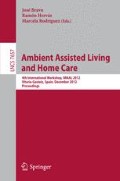Abstract
Emerging technologies enable new health delivery services based on Ambient Intelligence (AmI) concepts, Ubiquitous Health (U-Health) paradigm, and patient empowerment. However, these services show several drawbacks, being the lack of standardization one of the most important. The under development ISO/IEEE 11073 for Personal Health Devices (X73PHD) has substantially evolved during the last years. It defines the interface between agents and managers. Nevertheless, this standard has not been broadly tested. This paper presents a proof-of-concept implementation of a Electrocardiogram (ECG) recorder used in a real U-Health service. The functional model of this agent proposes several solutions to problems that, being out of X73PHD scope, were found during the implementation process. The hardware architecture describes four blocks: ECG acquisition and conditioning, storage, Bluetooth communication, and microcontroller. This paper also describes the Domain Information Model (DIM) used to model the agent and its objects. One of them is the Medical Device System (MDS). It provides general information about the agent. Another one is the ECG waveform object which represents the acquired ECG signal. In addition, the Device Status object indicates events related to malfunction. The last object defined is the periodic scanner which gathers observations and reports them to the manager. In addition, the service and communication models are also described. The former implements mandatory object access procedures. The latter defines association procedures and transport profiles, including Bluetooth Health Device Profile (HDP). The ECG recorder is integrated into a U-Health interoperable service using Android 4.0 smartphones and X73PHD.
Access this chapter
Tax calculation will be finalised at checkout
Purchases are for personal use only
Preview
Unable to display preview. Download preview PDF.
References
Monteagudo, J.L., Moreno, O.: eHealth for Patient Empowerment in Europe. World Wide Web electronic publication (2009), http://ec.europa.eu/informationsociety/newsroom/cf/itemdetail.cfm?item_id=3448 (last access: June 2012)
Donnan, G., Fisher, M., Macleod, M., Davis, S.: Stroke. The Lancet 371(9624), 1612–1623 (2008)
Remagnino, P., Foresti, G.: Ambient intelligence: A new multidisciplinary paradigm. IEEE Transactions on Systems, Man, and Cybernetics Part A: Systems and Humans 35(1), 1–6 (2005)
Rodriguez, M., Favela, J., Preciado, A., Vizcano, A.: Agent-based ambient intelligence for healthcare. AI Communications 18(3), 201–216 (2005)
Bonato, P.: Wearable sensors and systems. IEEE Engineering in Medicine and Biology Magazine 29(3), 25–36 (2010)
Teng, X.-F., Zhang, Y.-T., Poon, C., Bonato, P.: Wearable medical systems for p-health. IEEE Reviews in Biomedical Engineering 1, 62–74 (2008)
Kun, L.: Interoperability: The cure for what ails us (government affairs). IEEE Engineering in Medicine and Biology Magazine 26(1), 87–90 (2007)
Martínez-Espronceda, M., Martínez, I., Serrano, L., Led, S., Trigo, J., Marzo, A., Escayola, J., García, J.: Implementation methodology for interoperable personal health devices with low-voltage low-power constraints. IEEE Transactions on Information Technology in Biomedicine 15(3), 398–408 (2011)
Continua Health Alliance, http://www.continuaalliance.org (last visit: October 2010)
ISO/IEC/IEEE Health informatics-Personal health device communication-Part 20601: Application profile-Optimized exchange protocol. ISO/IEEE 11073- 20601:2010(E), pp. 1–208, 1 (2010)
Health informatics-Personal health device communication Part 10406: Device specialization-Basic electrocardiograph (ECG) (1- to 3-lead ECG). IEEE Std 11073-10406-2011, pp. 1–73, 30 (2011)
Author information
Authors and Affiliations
Editor information
Editors and Affiliations
Rights and permissions
Copyright information
© 2012 Springer-Verlag Berlin Heidelberg
About this paper
Cite this paper
Led, S. et al. (2012). A Wearable Electrocardiogram Recorder (ECG) Using ISO / IEEE 11073 Interoperability Standard. In: Bravo, J., Hervás, R., Rodríguez, M. (eds) Ambient Assisted Living and Home Care. IWAAL 2012. Lecture Notes in Computer Science, vol 7657. Springer, Berlin, Heidelberg. https://doi.org/10.1007/978-3-642-35395-6_25
Download citation
DOI: https://doi.org/10.1007/978-3-642-35395-6_25
Publisher Name: Springer, Berlin, Heidelberg
Print ISBN: 978-3-642-35394-9
Online ISBN: 978-3-642-35395-6
eBook Packages: Computer ScienceComputer Science (R0)

